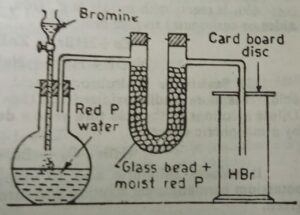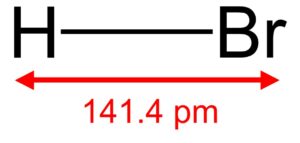Is HBr ionic or Covalent? This is what has been discussed in this article in detail along with other properties like polarity , ionic character etc.
Is HBr ionic or covalent . A very frequent question that strikes our mind when we consider its bond formation type. So in this article, we shall discuss about it along with important characteristics of HBr. Yes, HBr is covalent compound. The detailed explanation and facts are provided in the below sections .
First, let us see the preparation methods used for preparing HBr.
- A mixture is prepared by mixing of hydrogen and bromine, then this particular mixture has to be passed over the platinum spiral (which is electrically preheated). Then later the two elements combine together to give us HBr.

- There is another method for preparation which is considered a laboratory method. Hydrolysis of phosphorus bromide is carried out. A flask containing red phosphorus + water is taken and a funnel is fixed over it, then drop wise and slowly bromine is added to it from the funnel. The HBr vapors formed are then passed through a U-tube (which contains beads + moist red Phosphorus). This HBr is collected by setting up an assembly as shown in the figure.



Image credit : Textbook of inorganic chemistry by Sultan Chand and Sons
- One more method is by bromine reduction. This is a laboratory method which can be used to prepare HBr quite easily. In this method hydrogen sulphide (or sometimes sulphur dioxide) is bubbled through the bromine water (till its decolorization takes place).

Image credit : Wikipedia
Physical properties of HBr
- It is a colorless (gas) in nature
- It’s observed density is 25 degrees Celsius
- Its melting point is said to be -86.9 degrees Celsius and boils at a temperature of -66.8 degrees Celsius.
- Soluble in water (at around 0 degrees Celsius, 221g/100ml)
- Dissolves/soluble in alcohol (even organic solvents)
- Observed molecular geometry is linear.
Chemical properties of HBr: It is said to be incombustible and does not supports combustion.
Acidic Properties: 1) Observed that it turns moist blue litmus red.
2) Talking about reactivity, it has potential to react with metal and its oxides (hydroxides, carbonates)
Is HBr Covalent?
In order to understand if HBr is covalent or not, we first need to understand what do we mean by a covalent bond. So, a covalent bond (it is a chemical bond), bond formation takes place by involving sharing of pairs of electrons in between atoms. (Sometimes the electrons are referred to as bonding pairs).
Let’s have a look at some of their essential properties.
- They most of the times have lower melting and boiling points, meaning very less energy will be required to break the bonds as they are very weak (in comparison to metallic, ionic type of compounds). Also it has been observed that this compounds having covalent bonds, most of the times are liquid/gases (at room temperature).
- The enthalpy of vaporization and fusion is quite low as compared to ionic compounds.
- The intermolecular forces (referring to solid form) in between covalent compounds are quite weak and hence can be easily destroyed/distorted. (Meaning this type of compound are somewhat brittle).
- Talking about thermal electrical conductivity they are very poor conductors or we can also say that they do not conduct electricity. (The reasons for this is absence of charged particles which have potential to transport electrons).
So after understanding the concept of covalent bond can we now predict whether HBr is covalent? Yes, HBr is formed by covalent bond. Where hydrogen and bromine share their pair of electrons in between them and form a bond. As we know their melting point and boiling point are also less (discussed in the earlier section) and it is most of the time found in gaseous form.
The enthalpy of vaporization and fusion of HBr are 17.15 kJ/mol and 2.41 kJ/mol respectively and they are quite less and covalent compounds have this property in general. So HBr possesses most of the general properties of a covalent compound, so we can say HBr is a covalent compound.
Read more about : Is HBr Acid : Weak or strong, Why, How and Detailed Facts
Is HBr polar or nonpolar covalent?
Let’s understand the concept of polarity and nonpolarity first.
Polarity in molecules (general facts):
First of all what do we understand by polarity? Polarity means the electric charge separation in a molecule which gives rise to dipole (electric) moment, which has positive and negative charges towards their end. The force of attraction by which any atom attracts electrons is not same in all atoms and the force/pull by atoms on electrons is referred to as electronegativity of atoms.
When we say of higher electronegativity what we mean is the force/pull by which atoms attracts electrons is more and when we say lower electronegativity what we mean is the force/pull by which atoms attract is low.
So consider a bond, due to this concept of electronegativity what happens is the sharing of electrons between atoms is not equal as atoms having higher electronegativity will pull the electrons towards them. And we know that electrons carry a negative charge, this unequal electron sharing in a bond gives rise to the formation of an electric dipole.
Now, coming to the concept of polar and nonpolar molecules.
- A polar (molecule) means, it has on its one end a positive charge (more) and on the other end has a negative charge which leads or gives rise to the formation of an electrical dipole.
- A nonpolar molecule means, it will not have charges at the end of molecules the reason being that, the distribution of electrons is proper/finely and hence (symmetrically) they cancel each other.
After understanding the concept of polarity can we now predict whether HBr is polar or nonpolar covalent?
Referring to the polarity of HBr, the atoms of HBr molecule i.e. hydrogen and bromine have unequal electronegativity (meaning it can form a dipole moment). The electronegativity of bromine atom is quite more than the electronegativity of hydrogen atom and hence electrons are attracted (slightly) more towards the atom of bromine. Thus making HBr a polar covalent molecule.
Read more about : 5 Polar Covalent Bond Examples: Detailed Insights And Facts
Why is HBr covalent?
As we know HBr molecule is made up of hydrogen atom and bromine atom and both are non-metals. So the bond is formed by sharing (pairs of) electrons between non-metal atoms. This kind of bond formed is a covalent bond which has low melting and low boiling points. Hence HBr is made up of covalent bond.
Why is HBr polar?
In the earlier sections we have seen that polarity arises due to difference in electronegativity and gives rise to electric dipole. The electronegativity of hydrogen in HBr molecule is observed to be 2.1 and the electronegativity of bromine atom is seen to be 2.8 and the difference comes out to be 0.7.
As we can see that electronegativity of Bromine atom is quite more than that of hydrogen so it has the potential to attract / pull it more towards itself and this leads / gives rise to the formation of electric dipole. Thus HBr is a polar molecule.
HBr ionic character.
What we understand by ionic character of a compound is the percentage of electronegativity difference between atoms which are bonded by covalent bond.
We know that the electronegativity difference of the hydrogen and bromine in HBr molecule is 0.7 which is quite less. If the ionic character is more the compound will be ionic but if less that it will be a covalent compound. So we know ionic character of HBr is quite less hence it is polar compounds.
Also Read:
- Is baking soda ionic or covalent
- Alf3 ionic or covalent
- Is naf ionic or covalent
- Is k2o ionic
- How is nacl ionic
This is Sania Jakati from Goa. I am an aspiring chemist pursuing my post graduation in organic chemistry. I believe education is the key element that moulds you into a great human being both mentally and physically. I’m glad to be a member of scintillating branch of chemistry and will try my best to contribute whatever I can from my side and Lambdageeks is the best platform where I can share as well as gain knowledge at the same time.